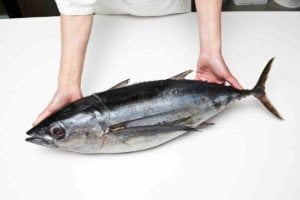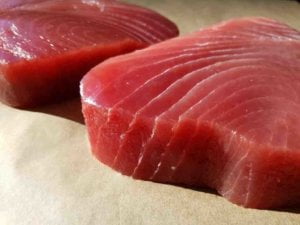
Tuna is a common fish ingredients that a lot of us have come to love. You can always find tuna bits in your bakery products, as your pizza toppings or served raw as a part of your sushi treats. Get your tuna facts here with us at Luxofood and you’ll love this excellent fish even more!
Tuna Types : What To Eat?
Here are the common types of tuna that you can find on your plate :
- Skipjack Tuna
The skipping and jumping tuna over the surface of the ocean, this variety is usually canned and is known as chunk light tuna. It generally has the strongest flavor and highest fat content and is also the smallest variety, seldom growing larger than 25 pounds. It is known as arctic bonito and aku—dried bonito is known as katsuobushi and is used in Japanese cuisine.
- Albacore Tuna
The lightest flesh and mildest flavor, Albacore is usually canned as white tuna and sold at a higher price than light chunk tuna. Since the mercury level is rather high in this type, it is recommended that young children and pregnant and breastfeeding women watch their intake.
- Bluefin Tuna
Tuna lovers, this is the one you want! With a bit more fat, bluefin tuna is more flavorful than the other varieties. When the bluefin is mature, the flesh is dark red, with an appearance similar to raw beef. This variety is the largest and is often exported to Japan and sold at a premium price for sashimi.
- Yellowfin (or Ahi) Tuna
A great substitute to the more expensive Bluefin, Yellowfin or also known as Ahi Tuna is nearly as good. Yellowfin is also more common and easy to find in the grocery store or fish market. It is pale pink, with flavor a bit stronger than albacore. It is also often canned.
Tuna Pricing : Cheap Vs Expensive
Have you ever wondered why fresh tuna is sold at high prices in a sushi restaurant, while a canned tuna at supermarket goes at a fraction of a price?
This all goes back to the types as explained above. Albacore or white meat tuna is quite abundant in both the Pacific and Atlantic, this is also the same fact for Skipjack, which are smaller fish compared to other types.
Sashimi grade comes from bigger and more scarce varieties such as Blue Fin or Yellow Fin, and is the kind that many people are willing to pay good money for its taste and flavor. Fresh tuna also requires more handling and care, which explains the price disparity.
Tuna Saku: What Is It?

In addition to fresh or canned tuna, you can also find tuna saku in the market.
Since a tuna fish can be quite big in size, it’s rare that you can purchase the whole carcass. So normally, fish producer will further processed tuna fish into what’s called tuna saku or a block of tuna meat with high quality. Tuna saku is typically made using Yellowfin or Bluefin.
The skin, bone and blood line on the tuna meat will be removed during the process. And to keep the fresh red color, tuna block is treated with cold smoke. It’s then vacuumed into individual pack to preserve the highest quality. Lastly, tuna block is stored to maintain its freshness and quality.
Tuna saku also tastes very flavorful and tasty since it’s made from high quality part of the tuna meat. It still retains the sweet moisture and firm texture. It’s mostly served raw as sushi or sashimi, and can also be made into steak ( about 200-500 gram per piece).
How to Select Fresh Tuna

Need a few tips to get your tuna fresh and well worth the money? Check out these few easy tips below :
- Look for moist ( not wet), shiny and almost translucent meat.
- Tuna cuts will turn brown or oxidizes after contact with knife, so avoid getting dull, matte or very brown tuna.
- When the meat of the muscle starts to separate into flakes or gapping, this is a sign of an old tuna.
- If possible, take a smell to find a fresh sea-air smell.
- Choose frozen tuna from your trusted food vendor, such as Luxofood.
Need more fish information? Check out our articles and get your fresh seafood supply from us!



